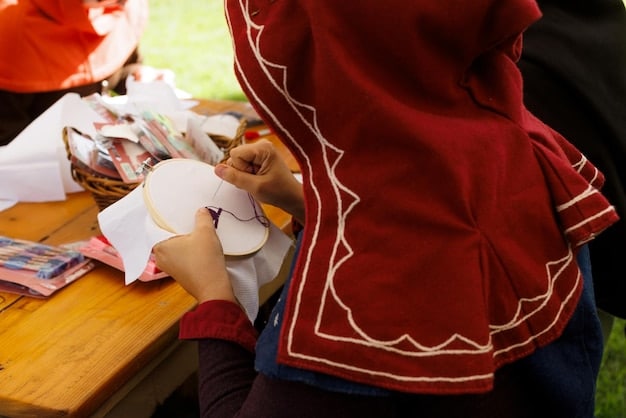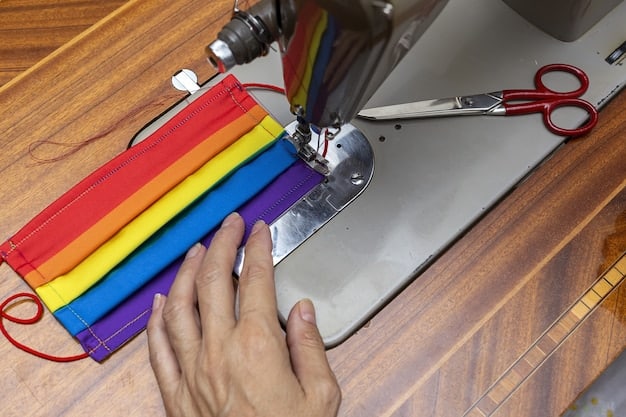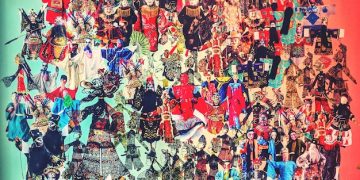The Ultimate Guide to Cosplay for Beginners

Cosplay, short for “costume play,” Involves dressing up as characters from various forms of media, like video games, anime, comic books, and movies, allowing fans to creatively express their fandom and connect with like-minded individuals.
Have you ever dreamed of becoming your favorite character from a video game, anime, or comic book? **Cosplay**, or “costume play,” makes it possible. It’s a vibrant hobby where you embody fictional characters through elaborate costumes and performances, offering a unique and rewarding creative outlet.
What is Cosplay? Defining the Art of Costume Play
Cosplay is more than just wearing a costume. It’s a performance art, a creative expression, and a social activity all rolled into one. It’s about bringing your favorite characters to life, sharing your passion with others, and becoming part of a vibrant community.
At its core, cosplay involves creating or sourcing costumes and accessories to resemble a specific character. This can range from simple, budget-friendly outfits to elaborate, meticulously crafted creations. Many cosplayers pour countless hours into researching, designing, and building their costumes, showcasing impressive craftsmanship and dedication.
The History of Cosplay
Cosplay’s roots can be traced back to the early 20th century in the United States, with fans dressing up for science fiction conventions and events. However, it truly took off in Japan, where it became a significant part of anime and manga culture.
The Appeal of Cosplay
Cosplay appeals to people of all ages and backgrounds for various reasons. Some enjoy the creative challenge of crafting costumes and props, while others relish the opportunity to express their fandom and connect with like-minded individuals. It’s also a chance to step outside of everyday life and embody a character they admire.
- Creative expression and craftsmanship
- Connection with fellow fans
- Escapism and role-playing
- Personal growth and confidence building
Cosplay fosters a strong sense of community. Cosplayers often gather at conventions, meetups, and online forums to share their work, exchange tips, and support each other. This creates a welcoming environment where everyone can celebrate their shared passion for pop culture.
Getting Started: Your First Cosplay Project
Embarking on your first cosplay project can feel daunting. However, by breaking it down into manageable steps, you can create a costume you’re proud of and have a blast in the process. The key is to start small and choose a character that genuinely excites you.
Start by choosing a character that resonates with your interests and skill level. Don’t feel pressured to tackle a complex design right away. Opt for a character with a relatively simple outfit and readily available references. This will make the process less overwhelming and more enjoyable.

Choosing The Right Character
Consider characters with outfits that align with your crafting abilities. If you’re new to sewing, a character with minimal tailoring and straightforward construction is a good choice. Similarly, if you’re unfamiliar with prop making, avoid characters with intricate weapons or accessories.
Planning and Budgeting Your Cosplay
Before you start buying materials, create a detailed plan. Sketch out the costume, noting all the different components and materials you’ll need. Research different techniques for creating each element, such as sewing patterns, prop-making tutorials, and wig-styling guides.
- Assess your current skills and identify areas where you may need to learn new techniques.
- Set a realistic budget for your project and factor in the cost of materials, tools, and any outsourced services.
- Create a timeline for completing your cosplay, breaking it down into smaller, achievable tasks.
Once you have a solid plan and budget, you can start gathering your materials and tools. This may involve shopping for fabrics, paints, foam, and other crafting supplies. You may also need to invest in some basic tools, such as a sewing machine, hot glue gun, and craft knife.
Essential Materials and Tools for Cosplay
The materials and tools you’ll need for cosplay will vary depending on the complexity of your project. However, some essential items are useful for almost any cosplay endeavor. Having these on hand will streamline your crafting process and help you achieve professional-looking results.
For the costume itself, fabric is the foundation. Choosing the right fabric can dramatically impact the look and feel of your cosplay. Natural fibers like cotton and linen are easy to work with and breathable, while synthetic fabrics like polyester and spandex offer durability and stretch.
Basic Sewing Supplies
A sewing machine, even a basic model, unlocks possibilities. Learn basic sewing stitches (straight, zigzag) and seam finishes. Practice on scrap fabric before tackling your cosplay. Measuring tape, pins, needles, thread, seam ripper, fabric scissors are essential handheld tools.
Prop Making Essentials
Craft foam (EVA foam) is a lightweight, versatile material that’s easy to cut, shape, and paint. It’s ideal for creating armor, weapons, and other accessories. Hot glue guns are great for strong quick bonds. Look for variable temperature models. Sandpaper comes in several grits for smoothing out rough edges. Invest extra money for good quality results.
- Craft knives: Use a sharp craft knife (like an X-Acto knife) and extra blades.
- Paints and sealers: Acrylic paints are versatile and easy to use for painting foam and other materials.
- Worbla: A thermoplastic that can be heated and molded into complex shapes.
When it comes to finishing touches, wigs can dramatically transform your appearance, instantly adding volume, length, and color. Look for heat-resistant wigs made of synthetic fibers, as they can be styled with heat tools. Hair wax and hairspray will help to shape and secure your wig.
Crafting Techniques: Sewing, Pattern Making, and Prop Creation
Developing your crafting skills is essential for creating impressive cosplays. Whether you’re sewing intricate costumes or building elaborate props, understanding basic techniques will empower you to bring your creative visions to life. Practice and experimentation are key to mastering these skills.
Sewing is a fundamental skill for many cosplay projects. Understanding basic stitches, seam finishes, and garment construction techniques will allow you to create custom-fitted costumes that look professional and polished. Look up some free templates online to use for your projects!

Understanding Basic Stitches
There are several essential stitches every sewer should know. Straight stitches, zigzag stitches, hand-sewing needles are a few for beginners. These form the basis of most seams and are used to join fabric pieces together.
Foam Fabrication Techniques
Foam fabrication has become increasingly popular. Cutting and gluing are crucial. Sharp craft knives are your friend. Use different blades for foam versus fabric. Contact cement creates a very strong bond. A light coat on each surface, let it get tacky, then press jointly.
- Heat shaping: Apply heat with a heat gun to bend and mold foam into complex shapes.
- Sealing and painting: Seal foam with Plasti Dip or Flexbond to prep for paint.
- Detailing: Add details with sanding, carving and attaching extra bits of foam.
Once you’ve mastered sewing and prop-making techniques, you can start experimenting with more advanced crafting methods. Consider techniques like using 3D printing and working with electronics to add lights and sound to your costumes. Don’t be afraid to push your boundaries and tackle new challenges – that’s how you’ll grow as a cosplayer.
Cosplay Makeup and Wig Styling: Achieving the Perfect Look
While the costume is a crucial component of cosplay, makeup and wig styling are essential for completing the transformation. These elements can enhance your likeness to the character and bring your cosplay to the next level. Mastering these techniques takes practice, but the results are worth the effort.
Cosplay makeup involves using makeup to enhance your features and create a more accurate portrayal of the character. This may involve contouring, highlighting, and using specialized products like face paint. A good foundation is critical to build your look upon.
Choosing the Right Makeup
Select products that suit your skin type. Are you oily, dry, or combination? Water-based or silicone-based products might perform better or be more comfortable. Study your character’s color scheme. Be accurate in your color selection.
Wig Styling Techniques
Wigs often require styling to match the character’s hairstyle. Brushes, combs, and scissors are the essential tool. Hairdryers, flatirons, and curling irons help style hair. Also use hair spray, gel, and wax to get the hair to behave.
- Start with a quality wig
- Use heat tools carefully
- Take your time and work in sections
With careful planning, practice, and attention to detail, you can master the art of cosplay makeup and wig styling. Don’t be afraid to experiment and try new techniques – the most important thing is to have fun and express your creativity.
Cosplay Etiquette and Convention Tips: Navigating the Cosplay World
Cosplay is a fun and rewarding hobby, but it’s important to be aware of cosplay etiquette and respect the rules and guidelines of conventions and events. Understanding these principles will help you navigate the cosplay world with grace and ensure everyone has a positive experience.
Cosplay is a diverse community with diverse backgrounds. Treat everyone with kindness, respect, and empathy. Approach cosplay with a positive attitude and leave negativity behind. Give sincere compliments for cosplays you admire.
Convention Etiquette
Conventions can be crowded, especially during peak hours. Be aware of your surroundings and avoid blocking walkways or obstructing views. Keep your props under control and be mindful of others around you. If you’re carrying a large or unwieldy prop, try to stay towards the edges of the crowd to avoid bumping into people.
Photography Etiquette
Always ask for permission before taking someone’s photo. Don’t take photos without consent or if you know they don’t want their picture taken. If someone agrees to a photo, be quick and efficient. Don’t take up too much of their time, especially if there are other people waiting to take pictures. If you’re taking a photo of someone in a revealing costume, be respectful and avoid taking suggestive or inappropriate shots.
- Respect personal boundaries
- Be mindful of convention rules
- Have fun and spread positivity
Bringing your A-game to respect and understanding will guarantee more opportunities and interactions within the community space. Whether you embody iconic heroes or obscure characters, the essence of cosplay thrives on mutual encouragement and shared enthusiasm.
| Key Element | Brief Description |
|---|---|
| 💡 Character Choice | Select a character that you love and that suits your skill level. |
| 🧵 Sewing Skills | Learn basic stitches and pattern adaptation for custom costumes. |
| 🎨 Foam Fabrication | Use EVA foam to create lightweight props and armor pieces. |
| 💄 Makeup Skills | Use makeup to enhance your likeness to characters. |
FAQ: Cosplay
How do I choose the right character for my first cosplay?
▼
Choosing the right character involves considering your interests, skill level, and body type. Pick someone whose outfit and accessories you can reasonably create or acquire. Start with simple designs to gain experience.
What are the essential tools for a beginner cosplayer?
▼
Essential tools include a sewing machine, fabric scissors, measuring tape, pins, a hot glue gun, a craft knife, sandpaper, and paints. These will cover basic costume and prop creation needs for starting out.
How do I manage my cosplay budget effectively?
▼
To manage your budget, start by setting a spending limit and tracking your expenses. Prioritize purchasing essential materials and look for affordable alternatives. Consider repurposing items or shopping at thrift stores.
What is cosplay etiquette at conventions?
▼
Cosplay etiquette includes asking for permission before taking photos, respecting personal space, and being mindful of convention rules. Treat fellow cosplayers and attendees with kindness and respect.
How can I improve my cosplay makeup skills?
▼
has created the perfect canvas for this look of grace and sophistication.
Read more content





